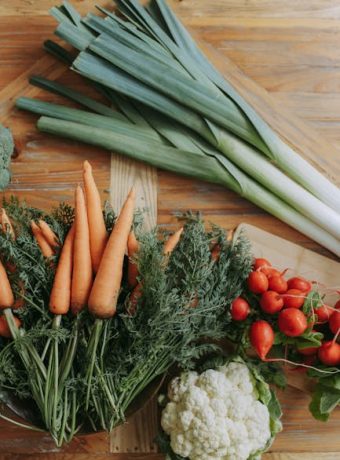Fall Vegetables: Best Choices for a Hearty Meal
As the weather turns cooler and the leaves start to change color, our cravings shift towards warm, hearty meals. Fall is the perfect time to embrace seasonal vegetables that not only add flavor to our dishes but also provide a wealth of nutrients. In this blog post, we’ll explore the best fall vegetables to incorporate into your meals, their health benefits, and some delicious recipes to get you started.
The Nutritional Power of Fall Vegetables
Fall vegetables are packed with vitamins, minerals, and antioxidants that support our health. According to the USDA, eating a variety of seasonal vegetables can improve our immune system, reduce the risk of chronic diseases, and promote overall well-being. Here are some key fall vegetables and their nutritional benefits:
1. Butternut Squash
Butternut squash is a versatile and nutrient-dense vegetable that can be roasted, pureed, or added to soups and stews. It is rich in vitamin A, vitamin C, potassium, and fiber. A single cup of cooked butternut squash provides over 450% of the daily recommended intake of vitamin A, which is essential for healthy vision and immune function.

Try making a creamy butternut squash soup for a comforting meal on a chilly day.
2. Sweet Potatoes
Sweet potatoes are another fall favorite that can be baked, mashed, or used in casseroles. They are an excellent source of beta-carotene, which the body converts into vitamin A, as well as vitamin C, manganese, and fiber. Sweet potatoes have a lower glycemic index compared to regular potatoes, making them a better option for maintaining stable blood sugar levels.

For a sweet and savory dish, try roasting sweet potato wedges with a sprinkle of cinnamon and a drizzle of maple syrup.
3. Brussels Sprouts
Brussels sprouts are small but mighty when it comes to nutrition. They are high in vitamins C and K, folate, and fiber. These cruciferous vegetables also contain glucosinolates, compounds that have been shown to have cancer-protective properties. Roasting Brussels sprouts brings out their natural sweetness and makes them a delicious side dish.

Roast Brussels sprouts with olive oil, salt, and pepper, then add a squeeze of lemon juice for a zesty finish.
Delicious Fall Vegetable Recipes
Now that we know the nutritional benefits of fall vegetables, let’s dive into some recipes that showcase their flavors. These recipes are easy to prepare and perfect for a hearty meal.
Roasted Root Vegetable Medley
This dish combines a variety of root vegetables for a colorful and nutritious side dish.
Ingredients:
- 2 cups butternut squash, peeled and cubed
- 2 cups sweet potatoes, peeled and cubed
- 1 cup carrots, peeled and sliced
- 1 cup parsnips, peeled and sliced
- 2 tablespoons olive oil
- 1 teaspoon dried thyme
- Salt and pepper to taste
Instructions:
- Preheat your oven to 400°F (200°C).
- In a large bowl, toss the vegetables with olive oil, thyme, salt, and pepper.
- Spread the vegetables in a single layer on a baking sheet.
- Roast for 25-30 minutes, or until the vegetables are tender and golden brown, stirring halfway through.
- Serve warm and enjoy!

Brussels Sprouts and Bacon Skillet
This savory dish pairs Brussels sprouts with crispy bacon for a delicious combination.
Ingredients:
- 1 pound Brussels sprouts, trimmed and halved
- 4 slices bacon, chopped
- 1 small onion, diced
- 2 cloves garlic, minced
- 1 tablespoon balsamic vinegar
- Salt and pepper to taste
Instructions:
- In a large skillet, cook the bacon over medium heat until crispy. Remove the bacon with a slotted spoon and set aside.
- Add the onion and garlic to the skillet and cook until softened, about 3 minutes.
- Add the Brussels sprouts and cook, stirring occasionally, until they are tender and caramelized, about 8-10 minutes.
- Stir in the balsamic vinegar and season with salt and pepper.
- Return the bacon to the skillet and toss to combine.
- Serve warm and enjoy!

Tips for Buying and Storing Fall Vegetables
To get the most out of your fall vegetables, follow these tips for selecting and storing them:
1. Choose Fresh and Firm Vegetables
When selecting fall vegetables, look for ones that are firm, free of blemishes, and have vibrant colors. Avoid vegetables that are soft, wrinkled, or have mold spots.
2. Store Vegetables Properly
Proper storage can extend the shelf life of your vegetables and maintain their nutritional value. Here are some general guidelines:
- Butternut Squash: Store in a cool, dark place for up to 3 months.
- Sweet Potatoes: Store in a cool, dry place for up to 2 weeks.
- Brussels Sprouts: Store in the refrigerator for up to 1 week.
3. Buy Local and Seasonal
Whenever possible, buy local and seasonal vegetables. They are often fresher, more flavorful, and have a lower environmental impact compared to out-of-season produce.
Conclusion
Fall vegetables are a fantastic addition to any meal, providing a wealth of nutrients and delicious flavors. From butternut squash to Brussels sprouts, these seasonal vegetables can be prepared in a variety of ways to suit your taste. By following our tips for buying and storing these vegetables, you can enjoy their benefits all season long. So, embrace the fall harvest and start cooking up some hearty and nutritious meals today!



